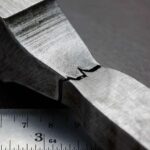Fundamentals of Fracture
Fracture is a form of failure where the material separates in pieces due to stress, at temperatures below the melting point. The fracture is termed ductile or brittle depending on whether the elongation is large or small. Steps in fracture (response to stress):
• Crack formation
• Crack propagation
Ductile Fracture
Stages of ductile fracture
– Initial necking
– Small cavity formation (micro voids)
– Void growth (ellipsoid) by coalescence into a crack
– Fast crack propagation around neck. Shear strain at 45o
– Final shear fracture (cup and cone)
The interior surface is fibrous, irregular, which signify plastic deformation.
Brittle Fracture
There is no appreciable deformation, and crack propagation is very fast. In most brittle materials, crack propagation (by bond breaking) is along specific crystallographic planes (cleavage planes). This type of fracture is transgranular (through grains) producing grainy texture (orfaceted texture) when cleavage direction changes from grain to grain. In some materials, fracture is intergranular.
Fracture occurs due to stress concentration at flaws, like surface scratches, voids,


Impact Fracture:
Impact fractures can best be described as a flute or strip of material that was cleanly sheared from a projectile point. The most common type of impact fracture starts at the tip of a point and runs down one blade edge possibly reaching the shoulder of a point. Some points were reworked into a useable point after having been damaged by an impact fracture. Normalized tests, like the Charpoy and Izod tests measure the impact energy required to fracture a notched specimen with a hammer mounted on a pendulum. The energy is measured by the change in potential energy (height) of the pendulum. This energy is called notch toughness.


